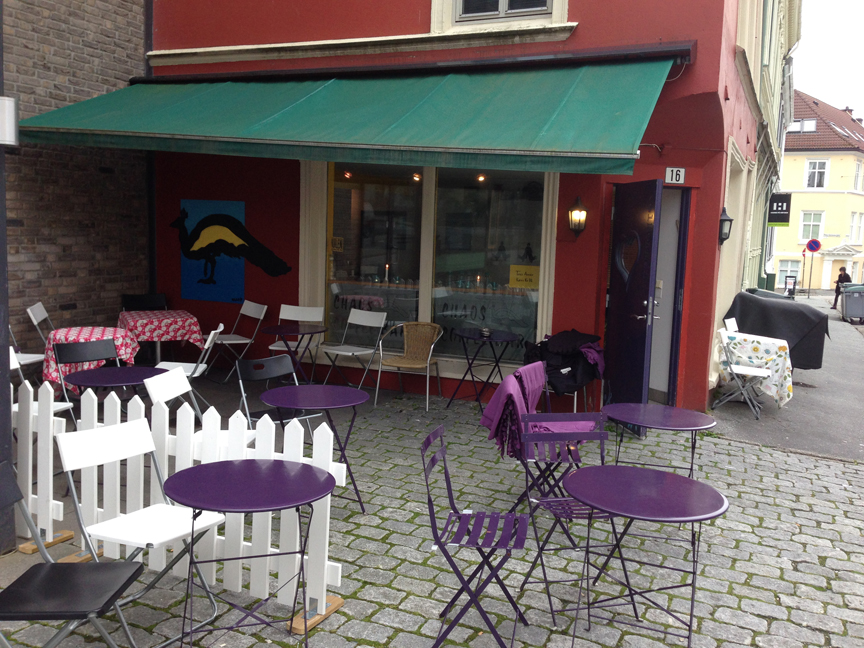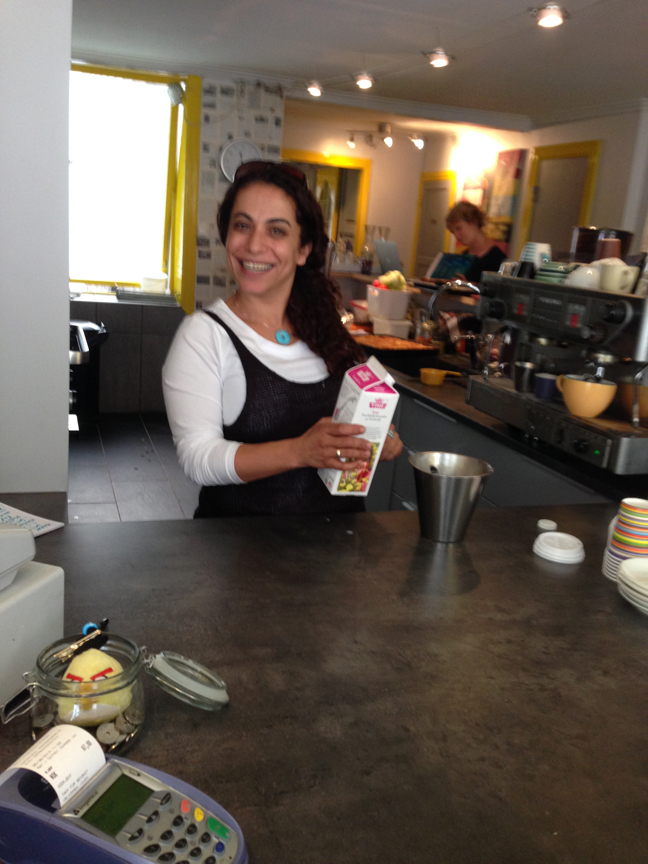Our two most precious currencies are time and attention. Money, our more conventional currency, helps to focus attention and to make us chary of how we spend our time.
I write this sitting in Chaos Coffee, perched at the edge of the University of Bergen campus and a block from Nygård Skole where W, my 9-year-old son, is in a Norwegian-language immersion program. Tuesday, the school lets out at noon, so I’ve made Chaos my hangout: they have plentiful wifi and don’t mind if I nurse a drink for a couple of hours while typing at a quiet table between a shelf of books on my right and the bright yellow door that leads into the back kitchen on my left.
Buying my second latte is a reckless extravagance. Then I throw all fiduciary sanity over my shoulder and add a small piece of dark chocolate cake.
It tastes better than it deserves. I wouldn’t pay attention if this were happening at a Peet’s in America, but in Norway the cake and latte cost 60 Kroner. Ten dollars! And I already spent nearly that on my first latte and an apple.
The cake feels ropy between my tongue and the roof of my mouth, then the chocolate lights up the taste buds at the sides of my tongue as that first mouthful heads south towards my esophagus.
Cognitive dissonance at play: regardless of the cause I’m experiencing this as mighty fine chocolate cake. The latte’s not bad either.
It’s just us boys for the next couple of days. Kathi, my wife, is at a conference in Oslo for Fulbright winners. H, our 13-year-old daughter, and J, our visiting 23-year-old nanny/niece/auxiliary kid, are on the train to join Kathi for the night. W & I plan to watch “X-Men First Class” on the laptop later, and there is talk of a post-school surgical strike to acquire some McDonald’s fries (a rare treat).
Today is my 13th day in Bergen and my second Tuesday morning at Chaos. Liat, who comes to Bergen from Tel Aviv, runs the café on these days.
She manages the music with a disk jockey’s care, pouncing on the stereo to manage sound levels and selecting a range of easy listening, orchestral, classic U.S. rock (Springsteen, Tracy Chapman), a smattering of current music (Passenger), Norwegian lounge music and more. At first, I was the only one here and she mentioned that “Vamp” was a famous Norwegian pop group. I’ll check them out on Spotify later.
Back to focused attention. I only vaguely recognize the Passenger tune “Let Her Go” and want to identify it, so I grab my iPhone and hit Shazam, then wince as I feel precious data trickle away. Oh no! What have I done? Until Kathi gets her Norwegian identity card (and, perhaps much later, we get ours) we can’t get bank accounts or mobile phone accounts, so we’re on pay-as-you go SIM cards. We are non-people living in a cash economy. Not a big deal in the long term, but I’m used to all-you-can eat data back home in the U.S.
Indeed, I only bought the pay-as-you-go SIM cards yesterday when I realized that the girls would be in different parts of Oslo and would have no way of reaching each other (or me) without them. The cost-per-TXT is .69 Kroner (about 11 cents), so we all use Skype for real-time communications.
I don’t miss having chronic mobile access and regret having it back now. Without the magic mirror in my pocket I pay more attention to my Norwegian surroundings, although the millisecond I find myself in a pocket of wifi (stand outside any Burger King and you can log on even without buying something, I learned) I grab the iPhone and peer into my digital other life. My info addiction is not subtle.
Now, with a SIM card, Skype bleeps whenever family and friends in the U.S. want my attention. It doesn’t happen often with the time difference (9 hours from the west coast), but I quickly have become accustomed to experiencing only local interruptions. In the same way that I’ve shed a few stubborn pounds because now I’m a pedestrian I had shed a few distractions by not having a smart phone. Now they are creeping back, forcing me to choose mindfully to turn off data or resist the urge to Google something, whereas yesterday geography made that choice for me.
Second meetings seem important in Norway. Liat and I had a pleasant interaction a week ago, but today I learn more about her. She is Israeli, married and still mourns the loss of her gigantic English mastiff a year ago.
Liat calls me to the front of the store to meet Marlis Bühler, who has just published a beautiful, poetic photography book of people with dolphins called “Dolphin Love.” Marlis, I think, is leaving Bergen tonight. She has come to Chaos to give Liat a copy of her book and say goodbye. That says a lot about the kind of coffee shop this is. Liat introduces me as “my new customer” to Marlis, which I find a unexpected and welcome compliment.
Right now, my time is chopped up seeing to the kids and the house and maintaining contact with various people and projects back in the U.S., so face-to-face human contact is at a premium.
It’s even harder for H, my daughter. Norwegian secondary schools are on strike and have been for nine weeks. The union and the administrators seem to get more sclerotic in their positions with each passing day, so I don’t know when the strike will end. So while W happily greets his buddies in the schoolyard at Nygård each morning, H doesn’t have a peer group.
Last Sunday, a colleague of Kathi’s with L, his 12-year-old daughter (and two 9-year-old boys for W) came to visit. Heaven. H lit up to have another girl to chat with, and they were quickly comparing notes on books, TV shows (who knew that “Gravity Falls” was an international hit?), YouTube videos, Instagram and more.
The moment I knew the visit had gone well came towards the end when we’d all gone out for an evening walk. As we approached our new friends’ car, L announced that she had to go back to our house because she had left her beloved iPad Mini there. We turned towards the house and I spied L quietly opening her coat to H in a “first one’s free” gesture that revealed the iPad in her pocket. L didn’t want to leave just yet. The two girls caught me catching them. We shared a conspiratorial smile.
We’ll find more girls for her to hang out with while we wait for school to start.
Less than two weeks into our 10-month stay here in Bergen it’s just thinkable for me to write about it. Until now, I’ve been too busy, too close, able to stick the occasional photo onto Facebook, but not able to do real thinking.
Bergen is a medieval city with a third millennial overlay. If Oslo, the business capital, is New York then Bergen is San Francisco or Boston. There is no Los Angeles equivalent in Norway: it isn’t sunny enough. Modern day hustle bustle squeezes through narrow, crooked and meticulously cobble-stoned streets. An ancient castle complete with dungeon sits next to a Radisson Blu mini hotel. There are more hair salons per capita than there are heads, which is odd because it’s not like this is a city of terrific haircuts. Everything is so expensive here that if I bother doing the Kroner-to-Dollars equation I’m frozen in place: how much for a pack of gum?
And with that, ‘tis time to get the boy from school.


Leave a Reply